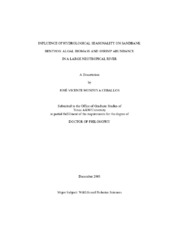| dc.description.abstract | In this study, I examined the influence of hydrological seasonality on
spatiotemporal variation of algal biomass and shrimp abundance on sandbanks of the
Cinaruco River in southwestern Venezuela. Seasonal variations of abiotic and biotic
variables in the Cinaruco were driven by the hydrological regime. During the highwater
periods, river sites in the main channel and lagoon sites were similar in water
physicochemical variables and algal biomass. In contrast, physicochemical variables
and algal biomass differed between river and lagoon sites during the low-water period.
The absence of flow in lagoons and consistently low algal biomass on river sandbanks
were the most important features of the spatial variability between main-channel and
lagoon sandbanks during low-water phases. Benthic algal biomass was highly uniform
at small spatial scales and significantly heterogeneous at large spatial scales. In the
second major part of this dissertation, I found a relatively species-rich shrimp
assemblage with seven species inhabiting the sandbanks of the Cinaruco. I also
observed clear patterns of temporal and spatial variation in shrimp abundance on the
Cinaruco sandbanks. Abundance of shrimp on the sandbanks presented remarkable diel variation, showing almost exclusive use of this habitat at nights. Seasonally, shrimp
were more abundant during rising- and falling-water periods, when rapid changes of
environmental conditions occur. Shrimp abundance was high on those sandbanks with
absence of troughs and presence of submerged vegetation. These environmental features
presumably promote colonization/establishment and survival/persistence of shrimp in
the sandbanks. In a patch-dynamic view of communities, a mobility control model
seems to apply to shrimp of the sandbanks in the Cinaruco during the period of rapid
changes in hydrology and habitat structure. During low-water periods, when habitat
structure of sandbanks is relatively constant, low shrimp abundance appears to be
heavily controlled by high fish predation. The annual flood regime of the Cinaruco,
which drives the concentrations of dissolved materials, affects material interchanges
between aquatic and terrestrial systems, and modifies aquatic habitat structural
complexity, is responsible for creating strong patterns of seasonal and spatial variation in
benthic algal crops and shrimp abundance on the sandbanks of this large floodplain
river. | en |


